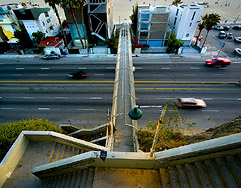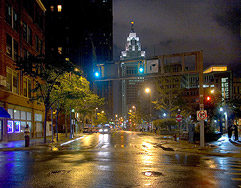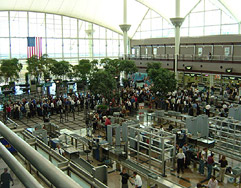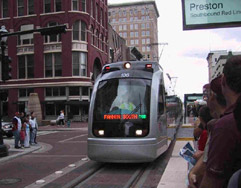For high speed rail, manna from heaven?
by Fred Frailey
Trains Magazine
It appears that what President Dwight Eisenhower did for highways more than half a century ago, launching an interstate, limited-access network, President Barack Obama is trying to do for the passenger train. The White House yesterday proposed a six-year, $53 billion plan for extending the embryonic network of high- and higher-speed trains. For details, go here. This follows $10.5 billion already committed in 2010.
Like many of you, I applaud the spirit of what the president proposes. But do I have confidence much will come of it? No, although I wouldn’t mind at all being proved wrong. Here are my five concerns.
First, where’s the money? The newspaper Politico reported this week that Democrats are joining Republicans in the budget-cutting fiesta. Amtrak’s entire appropriation is at risk. Do I think Amtrak will be cut back to the Northeast Corridor or junked altogether this year? No, but I have to wonder whether Obama’s request to Congress for the first $8 billion of this $53 billion will go anywhere given political realities.
Second, where’s the vision? You can’t just announce something like this and expect the nation to march behind you. Somebody has to sell this idea. Nobody did last year when the first $10.5 billion was passed around, and look what happened. It became the punching bag of Republican office seekers, who profited from apparent public indifference to higher-speed passenger rail. So some serious beating of the tom-toms is needed to drum up support, or this will sink like a stone, becoming a one-day news story with no follow-through.
Third, where’s the expertise? When the high speed grants were first made a year ago, it fell to the Federal Railroad Administration to run the program. In FRA’s defense, it had no experience in this field and few if any people. A hiring frenzy ensued, and the learning curve began. I would give FRA a grade of “D” so far in getting the funded projects going. Only 40 percent of that initial $10.5 billion awarded last year has been let loose, as FRA, the states, and the Class I railroads haggle over service outcomes stretching 20 years into the future. It’s so bad that Amtrak is now doing much of the negotiating for FRA people, creating a sort of conflict of interest, inasmuch as Amtrak is a player in these grants. If the Federal Railroad Administration remains on the same trajectory of competence it now occupies, well, very little will get done.
Fourth, where are the partners? I’m coming around to the point of view of John Mica, the Florida Republican who chairs the Transportation and Infrastructure Committee of the U.S. House of Representatives. Mica champions public-private partnerships, in which corporations put up money and manpower to bring these complex projects to life. Florida is about to go down this path with its high speed line connecting Orlando to Tampa, by asking for proposals, unless its new governor pulls the plug on the whole enterprise. True high speed rail is too big to be brought about without involvement of the private sector.
Fifth, where are the details? Last year’s 104 grants covered every geographic nook and cranny. But the vast majority of the grants involve only consultants, to study this idea and that. Only a relative handful involved real construction, and to my knowledge, as of today, there are exactly three jobs underway, in Illinois, Maine, and Vermont. This time — this year — will significant money go to the Northeast Corridor as it did not last year? If and when the details come forth, the president’s initiative will begin to flesh out, and maybe answers to my other questions will begin to suggest themselves.
So yes, I’m supportive but skeptical. The first year of our new era of high speed rail was something of a bust. The players in this game must get a lot better. That, or we’re in for a big disappointment. —
…
To Our Readers:
We reproduce below an excerpt from a lengthy (4,500-word) and well-documented commentary titled “Time to End Obama’s Costly High-Speed Rail Program,” by Ron Utt, Senior Research Fellow at The Heritage Foundation. Utt is known for his well-researched studies in the transportation sector. He has a large following among conservative lawmakers and staffers on Capitol Hill.
While we do not necessarily agree or endorse Ron’s conclusion, we think his provocative view (and indeed the entire commentary) is worth our readers’ attention.
The complete commentary can be accessed at :
http://www.heritage.org/Research/Reports/2011/02/Time-to-End-Obamas-Costly-High-Speed-Rail-Program
Time to End Obama’s Costly High-Speed Rail Program
by Ronald Utt, The Heritage Foundation
February 11, 2011
Abstract: President Barack Obama’s high-speed rail program promises to spend hundreds of billions of dollars in federal and state funds to provide mediocre passenger rail service to an extremely small fraction of travelers. In this time of tight budgets, neither the federal government nor the states can afford such extravagance. Instead of creating a heavily subsidized, underutilized passenger rail system, Congress and the Administration should promptly end the program and use the recovered funds to reduce the federal budget deficit.
The Real Reason for High-Speed Rail or Any Rail
With all of the evidence indicating that HSR is an exceptionally costly and inefficient means of travel that only a few passengers choose to use, it is difficult to explain the obsession of some, including the President and members of his Cabinet, with this mode of travel. In part, this obsession seems to have little to do with travel per se, but rather with the quality of the travel experience.
Secretary LaHood apparently believes that this is an appropriate federal goal. He has observed, “People like to ride trains.… You don’t build these trains to travel faster, although sometimes you do,” and added that “people could read books, work on their computers, eat and perform other tasks on trains that are difficult or illegal to do while driving.”[25]
Secretary LaHood’s clumsy defense of the costly inefficiency of rail travel was expressed more elegantly, spiritually, and nonsensically by the late British historian Tony Judt:
If we lose the railways we shall not just have lost a valuable practical asset
whose replacement or recovery would be intolerably expensive. We shall have
acknowledged that we have forgotten how to live collectively. If we throw away
the railway stations and the lines leading to them—as we began to do in the
1950s and 1960s—we shall be throwing away our memory of how to live the
confident civic life.… If we cannot spend our collective resources on trains
and travel contentedly in them it is not because we have joined gated
communities and need nothing but private cars to move between them. It will be
because we have become gated individuals who don’t know how to share public
space to common advantage. The implications of such a loss would far transcend
the demise of one system of transport among others. It would mean we had done
with modern life.[26]
This, apparently, is a rationale for spending billions of dollars on a travel mode that few people will ride. On the one hand, passenger rail allows people to eat and to play with their computers, but on the other hand, it allows them to share public space to common advantage, retrieve the memory of living the confident civic life, and remember how to live collectively.
While intriguing, exotic, and potentially therapeutic to some lonely souls, retrieving a memory of living the confident civic life does not seem worth the several hundred billion dollars the plan would cost. Congress and the President could do well by identifying higher priorities that better merit federal attention.
[25]Ray LaHood, quoted in Nash, “Official: Trains Are the Ticket.”
[26]Tony Judt, “Bring Back the Rails!” The New York Review of Books, January 13,
2011, p. 35, at http://www.nybooks.com/articles/archives/2011/jan/13/bring-back-rails/ (February 7, 2011).
…
High-Speed Rail is a Fast Track to Government Waste
By Robert J. Samuelson
The Washington Post, February 14, 2011
Vice President Biden, an avowed friend of good government, is giving it a bad name. With great fanfare, he went to Philadelphia last week to announce that the Obama administration proposes spending $53 billion over six years to construct a “national high-speed rail system.” Translation: The administration would pay states $53 billion to build rail networks that would then lose money – lots – thereby aggravating the budget squeezes of the states or federal government, depending on which covered the deficits.
There’s something wildly irresponsible about the national government undermining states’ already poor long-term budget prospects by plying them with grants that provide short-term jobs. Worse, the rail proposal casts doubt on the administration’s commitment to reducing huge budget deficits. The president’s 2012 budget is due Monday. How can it subdue deficits if it keeps proposing big spending programs?
High-speed rail would definitely be big. Transportation Secretary Ray LaHood has estimated the administration’s ultimate goal – bringing high-speed rail to 80 percent of the population – could cost $500 billion over 25 years. For this stupendous sum, there would be scant public benefits. Precisely the opposite. Rail subsidies would threaten funding for more pressing public needs: schools, police, defense.
How can we know this? History, for starters.
Passenger rail service inspires wishful thinking. In 1970, when Congress created Amtrak to preserve intercity passenger trains, the idea was that the system would become profitable and self-sustaining after an initial infusion of federal money. This never happened. Amtrak has swallowed $35 billion in subsidies, and they’re increasing by more than $1 billion annually.
Despite the subsidies, Amtrak does not provide low-cost transportation. Longtime critic Randal O’Toole of the Cato Institute recently planned a trip from Washington to New York. Noting that fares on Amtrak’s high-speed Acela start at $139 one-way, he decided to take a private bus service. The roundtrip fare:
$21.50. Nor does Amtrak do much to relieve congestion, cut oil use, reduce pollution or eliminate greenhouse gases. Its traffic volumes are simply too small to matter.
In 2010, Amtrak carried 29.1 million passengers for the entire year. That’s about about 4 percent of annual air travel (2010 estimate: 725 million passengers). It’s also roughly a quarter of daily automobile commuters (124 million in 2008). Measured by passenger-miles traveled, Amtrak represents one-tenth of 1 percent of the national total.
Rail buffs argue that subsidies for passenger service simply offset the huge government support of highways and airways. The subsidies “level the playing field.” Wrong. In 2004, the Transportation Department evaluated federal transportation subsidies from 1990 to 2002. It found passenger rail service had the highest subsidy ($186.35 per thousand passenger-miles) followed by mass transit ($118.26 per thousand miles). By contrast, drivers received no net subsidy; their fuel taxes more than covered federal spending. Subsidies for airline passengers were about $5 per thousand miles traveled. (All figures are in inflation-adjusted year 2000 dollars.)
High-speed rail would transform Amtrak’s small drain into a much larger drain. Once built, high-speed-rail systems would face a dilemma. To recoup initial capital costs – construction and train purchases – ticket prices would have to be set so high that few people would choose rail. But lower prices, even with favorable passenger loads, might not cover costs. Government would be stuck with huge subsidies. Even without recovering capital costs, high-speed-rail systems would probably run in the red. Most mass-transit systems, despite high ridership, routinely have deficits.
The reasons passenger rail service doesn’t work in America are well-known: Interstate highways shorten many trip times; suburbanization has fragmented destination points; air travel is quicker and more flexible for long distances (if fewer people fly from Denver to Los Angeles and more go to Houston, flight schedules simply adjust). Against history and logic is the imagery of high-speed rail as “green” and a cutting-edge technology.
It’s a triumph of fancy over fact. Even if ridership increased fifteenfold over Amtrak levels, the effects on congestion, national fuel consumption and emissions would still be trivial. Land-use patterns would change modestly, if at all; cutting 20 minutes off travel times between New York and Philadelphia wouldn’t much alter real estate development in either. Nor is high-speed rail a technology where the United States would likely lead; European and Asian firms already dominate the market.
Governing ought to be about making wise choices. What’s disheartening about the Obama administration’s embrace of high-speed rail is that it ignores history, evidence and logic. The case against it is overwhelming. The case in favor rests on fashionable platitudes. High-speed rail is not an “investment in the future”; it’s mostly a waste of money. Good government can’t solve all our problems, but it can at least not make them worse.
…
Obama’s high-speed rail plan is a fiscal pipedream
The Wall Street Journal, February 14, 2011
We suppose every President is entitled to a pipedream, but President Obama’s vow in his State of the Union address that 80% of Americans should have access to high-speed rail in 25 years is a doozy. Vice President Joe Biden has followed up by proposing $53 billion in high-speed rail funding over the next six years. Seriously?
On recent evidence, this train is running in reverse. Though the Obama Administration has allocated more than $10 billion for high-speed rail projects the past two years, the new Republican governors of Wisconsin and Ohio, Scott Walker and John Kasich, have rejected the federal money. They don’t want to put their taxpayers on the hook for projects destined for Insolvency Junction. Florida Governor Rick Scott is also reconsidering his state’s proposed Orlando-Tampa line.
Even California, that famous incubator of pipedreams, is having second thoughts. The state has proposed an 800-mile high-speed rail plan from San Diego to San Francisco. Bay area residents are now protesting that the line will damage property values, while Central Valley farmers complain the line will ruin their land. The greater wonder is how the state will pay for a $43 billion train even as it’s facing a $28 billion budget gap over the next 18 months and $20 billion annual deficits four years after that.
Two years ago California taxpayers approved a $9.95 billion bond initiative to fund the train, buying the pitch that it would create hundreds of thousands of jobs and attract 94 million riders. The state’s high-speed rail authority told voters a one-way ticket from San Francisco to Los Angeles would cost $55—about
the price of a Southwest flight. They said private equity firms were dying to invest, and that the train would operate without a public subsidy.
Studies by economists and financial consultants Alain Enthoven, William Grindley and William Warren have since debunked the rail authority’s claims. Based on the costs of high-speed rail lines in Europe and Japan, the price tag likely will fall between $62 billion and $213 billion. A one-way ticket from San Francisco to Los Angeles will cost about $190, which means more people will choose to fly.
Because of uncertainty over costs and ridership forecasts, private equity firms say they won’t invest without a revenue guarantee, i.e., an operating subsidy. Even if the state somehow manages to attract $10 billion in private equity, its business plan calls for another $5 billion in local grants and $15 billion more in federal funds. The $15 billion that they want from the feds would be nearly a third of Mr. Biden’s $53 billion figure. Maybe high-speed rail is a back-door bailout for California.
Messrs. Obama and Biden argue that the U.S. has to invest in high-speed rail to stay competitive with the world. Only if we’re competing in the Debt Bowl. Two high-speed railways in the world have broken even, and those are in densely populated areas of France and Japan where people drive less because gas prices are twice as high as in the U.S., and many foreign intercity highways levy tolls.
The only area of the United States where high-speed rail begins to make sense is along the high-traffic, high-population Northeast Corridor from Washington,
D.C., to Boston. Amtrak’s Acela peaks at 150 miles per hour but averages only about 70 miles per hour because it has to share tracks with other trains. A truly high-speed rail that runs on its own dedicated track could reach 220 mph and cut the travel time nearly in half.
While such a line might offer benefits for the region’s commuters, Amtrak estimates the line would take 25 years to develop and cost $117 billion. According to a 2009 study by the Congressional Research Service, six to nine million riders would need to take the train each year to justify the costs of high-speed rail systems similar to those in other countries. The Acela carried 3.4 million people in 2008.
Until the proponents of high-speed rail solve the problem of runaway costs, we’ll stick with the train in Disney’s Fantasyland. Who knows, maybe 80% of the country has taken it for a ride by now.
Copyright 2011 Dow Jones & Company, Inc. All Rights Reserved
…
C. Kenneth Orski is a public policy consultant and former principal of the Urban Mobility Corporation. He has worked professionally in the field of transportation for over 30 years, in both the public and private sector. He is editor and publisher of Innovation NewsBriefs, now in its 22nd year of publication.
Tags: Barack Obama, C. Kenneth Orski, Fred Frailey, HSR, Joe Biden, Ken Orski, Obama Administration, Robert J. Samuelson, Ronald Utt, The Heritage Foundation, The Wall Street Journal, The Washington Post, Trains Magazine






 RSS Feed
RSS Feed
I like your comments about partners, but in this as in so many political issues I see so very little discussions of principle. Let’s start with the idea that competition is the best regulator. Then how do you regulate something like rail service (within rail industry, not reflecting the influence of roads and airtravel)? Answer is to look at and separate the elements; for brevity, I’d suggest separation of railways from trains. The former might best be addressed by goverment action, just as are roads, as long as the latter goes unregulated (except for such items as safety, traffic control, etc). This principle matches your comment about public/private endeavors. Unfortunately, too many such “partnerships become a cozy relationship between fox and hens, with subsidies to private corporations based in reality on their political pull (aka contributions). I’m a staunch Libertarian capitalist, but I do believe there’s a place for government in certain enterprises, e.g., when there is no effective competition to regulate commerce. The same might be said about the power grid; let private enterprise produce power, public distribute it as there is only one line to your house. An important caveat: review such arrangements constantly. Once there was only one phone line to your house. Thus said, let government start buying up rail lines with the understanding that it shall never get into trains, and further encourage (through tax incentives) those who receive payment for the railways purchased to invest those payments in trains (high speed, of course). My entire point is adherence to the basic principle cited, free enterprise competition is still the best regulator, WHERE AVAILABLE.